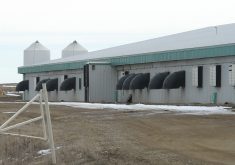Early harvest returns indicate the pea crop might be far smaller than Statistics Canada’s July 31 production estimate.
Saskatchewan Agriculture is reporting average yields of 30 bushels per acre in southeastern and southwestern Saskatchewan and 32 bu. in the east-central part of the province.
Harvest is well underway in those regions, with 61 percent of the peas combined in the southeast, 63 percent in the southwest and 27 percent in east-central.
Read Also

Phosphate prices to remain high
Phosphate prices are expected to remain elevated, according to Mosaic’s president.
Two-thirds of the 2008 pea crop was planted in those three regions. Assuming the same seeding pattern, that would mean two-thirds of the 2010 crop would be in the 30 to 32 bu. range.
Yields are higher in the west-central and northwest portions of the province and lower in the northeast but little has been combined in those areas.
Provincial cropping management specialist Grant McLean thinks 30 to 32 bu. per acre could be this year’s provincewide average, although it is difficult to tell due to wildly varying yields.
Greg Simpson, who farms near Moose Jaw, Sask., thinks his peas will yield 30 bu. The owner of Simpson Seeds figures the provincial average won’t be far off that number.
That would be much lower than Statistics Canada’s 35.5 bu. average yield.
“It would certainly mean less production and supply,” said Sergio Novelli, market analyst with Agriculture Canada.
An average yield of 32 bu. would result in 2.8 million tonnes of peas, down from Statistics Canada’s 3.1 million tonne estimate.
“In terms of prices, that’s good.”
In its Aug. 31 outlook, Agriculture Canada forecast average pea prices would fall from 2009-10 levels due to the large anticipated supply.
“We’ve got a lot of peas out there. Maybe if the production is down a little bit, that’s not necessarily a bad thing,” said Novelli.
Agriculture Canada is forecasting 2.5 million tonnes of pea exports in 2010-11, up from 2.2 million tonnes last crop year due to expected increased demand from the Indian subcontinent.
That conflicts with reports out of India indicating that kharif or summer pulse planting is up 21 percent due to good monsoon rains.
The Pulses Importers Association of India is forecasting an extra one million tonnes of production over the previous kharif harvest and a corresponding 15 to 25 percent decline in local pulse prices in October when the new crop arrives.
Novelli said he expects strong demand from India because yellow pea consumption is growing by 250,000 tonnes per year based on population growth alone.
Indian demand will depend on prices, which depends on how big of a crop Canada harvests and how much is downgraded to feed.
McLean said quality is variable this year. However, it is clear there has been some bleaching damage due to the wet weather.















